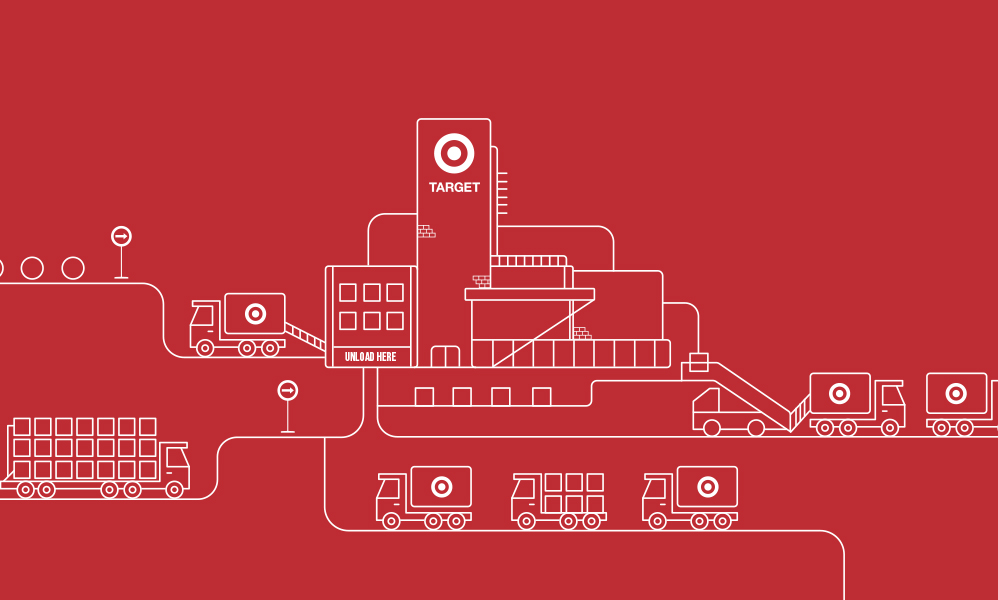Is Target selling its excess inventory on eBay & Poshmark?

For years, online lurkers on forums like Redditors have wondered if a mysterious third-party seller on eBay and Poshmark was simply Target in disguise. It turns out they were sort of correct.
An eBay account called Bullseye Deals has been live since 2013, boasting 137,000 followers and over 2.6 million items sold. All of its products seem to be from Target. An identical account on Poshmark was launched in 2022 and has already amassed over 20,000 followers. Bullseye Deals’ branding, while not a perfect replica of the big-box retailer’s logo, is a red dot with the silhouette of a bull inside, which looks an awful lot like Target’s bullseye.
These Bullseye Deals e-commerce accounts offer very little explanation beyond the products themselves. The eBay storefront’s description simply says “Resell – Reuse – Recycle.” But, they feature the wide array of products one might buy in a big-box store, from linens to home goods to children’s toys. Some listings are for items from Target’s private label lines, such as A New Day, Boots & Barkley, and Casaluna. These products are usually listed as new, open box or pre-owned — and are priced less than what they were originally sold for at Target. For example, a floor lamp listed as new on Bullseye Deals is selling for $21.99 compared to an $80 price tag on Target.com.
It’s not unheard of for a retailer to offload excess merchandise, what the industry calls salvage. In fact, it’s commonplace. Stores like TJ Maxx and Burlington source their off-price products by working with retailers and brands. Similarly, reverse logistics businesses exist to help consumer-facing brands deal with excess products that can’t be put back on shelves, like returned or discontinued items. Often, these companies will buy excess inventory in bulk from major retailers and then find ways to resell it themselves, be it selling entire pallets of product or inking deals with clearance retailers like bin stores.
Bullseye Deals technically falls into this latter category, though it is branded in a way that at least hints at it being associated with Target. Sources tell Modern Retail that all the listings are salvage merchandise from Target that’s been purchased by the reverse supply chain services company Liquidity Services, Inc.
A Target spokesperson confirmed to Modern Retail that the company that runs the Bullseye Deals account does buy salvage merchandise from Target and sells it. Liquidity Services, Inc. did not respond to a request for comment.
Unsellable inventory is a big problem for retailers. According to a 2023 estimate from eMarketer, total retail returns hit $613.94 billion, representing 8.5% of total retail sales. And that doesn’t represent all the products a retailer might offload because it can’t sell it anymore.
Retailers are often unable to put returned items back on the shelves if, for example, a box gets opened or a product gets lightly used before being returned. Additionally, when factoring in labor and other costs, it might not be worth it for retailers to put some items back on the store floor. For a company like Target — which lets customers return things within 90 days for a full refund — it’s almost certainly swimming in salvage merchandise and is trying to figure out ways to avoid throwing it all out.
Matt Miller, the president and chief operating officer at Mac Wholesale, said there are some examples of retailers including their own branding when selling excess merchandise. Mac Wholesale buys closeout inventory from brands and sells it to other channels like off-price retail. Miller pointed to Best Buy, which has its Outlet program that sells refurbished, clearance and open-box electronics. Similarly, both Macy’s and Nordstrom have off-price outposts like Backstage and Rack.
Miller, however, has never heard of retailers launching e-commerce seller accounts to resell merchandise — nor has he seen reverse logistics businesses build individual online storefronts to mimic the branding of the retailer from which they purchased.
What piqued his interest specifically about this Target example was the fact that Bullseye Deals seems to have all sorts of products, price points and conditions. For example, Miller found a pre-owned Luigi plush toy for around $11. “Most retailers aren’t going through that hassle,” he said. And while it’s true that Target itself isn’t specifically uploading a listing for a stuffed toy, the company it works with is — and is doing it for tens of thousands of products to platforms like eBay.
Target doesn’t control this Bullseye Deals inventory, but it is aware that its reverse logistics partner is doing this. And, according to Miller, it’s a smart way for a retailer to handle merchandise that would otherwise go to the landfill. Especially for a company like Target, which has owned brands that it likely would not like to see show up at other retail stores like TJ Maxx, “it allows them to control the liquidation of their own private-label brands,” Miller said.
Similarly, for other brands that sell at Target, if Target decides to discontinue a product, an e-commerce account like Bullseye Deals is probably more palatable than seeing an item in its clearance section. If a brand is trying to sell to other retailers, “they are going to say ‘what’s wrong if Target is clearance-ing it?'” Miller said.
While Bullseye has been around for years, Miller isn’t surprised that it’s become a popular destination for shoppers nowadays. “Most off-price retailers that would have never considered off-price retail five years ago are considering it now,” he said.
Meanwhile, Target — with the help of an intermediary — has been essentially doing this in the shadows. Miller, for one, was shocked he hadn’t seen the Bullseye Deals account until now. “I’m surprised it hasn’t been more visible with that many transactions and that much feedback, he said.

